14th August 2024
Few things in teaching polarise opinions as much as reading activities. Some educators argue that reading comprehension questions are inauthentic. They detract from the joy of reading. Instead of inspiring students to read, reading comprehension questions train students to find correct answers. Reading comprehension questions aren’t popular because they further learning - they’re just easy to grade.
On the flip side, some teachers would say that the above arguments are only true for badly written reading comprehension questions. Well-written reading comprehension questions can stimulate classroom discussion, promote critical thinking and help learners get more out of a text than they would otherwise. And some teachers might even tell you they only have time for reading comprehension questions. They need to prepare their students for reading exams. They don’t have time for discussions.
Regardless of your view, you need to do reading activities with your students. After reading a text you’ll want your students to do something. But what? It can be difficult to make decisions about what questions to ask, what language to focus on and how to encourage meaningful discussion about what learners have just read. In this blog post we’ll look at using AI to help with the process of creating activities to go with written texts. We’ll look at using AI to generate everything from true or false comprehension questions, to analyzing the language in a text, to generating ideas for speaking activities.
Why Do Reading Activities?
No one is going to ask you any questions after you read this blog post. So why would we ask students questions after they read something in class?
- To check that students understand. Reading and understanding happen in the brain, hidden from view. It’s impossible to tell if (or what) students understand without talking to them afterwards.
- To practice reading. Reading is a skill. Just like swimming, ice skating or riding a bike, you can’t get better at reading without doing it. Reading questions simulate the different purposes that students read for outside of class.
- Identifying language. A lot of time in language classes, two or more birds are killed by a single text. A text might practice a reading skill as well as introducing students to new language in context. Asking questions after reading something can help students notice the new vocabulary. Another bird a text can kill is…
- ... as a springboard to speaking. Discussing something interesting, controversial or thought provoking is an authentic and effective way to get learners to talk.
- If you’re teaching kids, the questions you ask students about these texts can develop their critical thinking skills. Even if this isn’t one of your goals in teaching English, the more you get students to think, the more they’re likely to remember.
- Preparing for tests. Most English tests ask students to read something, then answer questions. If you want to prepare your students for such tests, you’ll need to do something similar in class. And that means using reading comprehension questions.
Of course, you could just use the reading comprehension questions from your coursebook. But if you’re creating your own materials for class, writing an interesting text is only half of the puzzle. You’ll need some reading activities to go with the text. And that’s where AI comes in.
What do Comprehension Questions Look Like?
I know you’re thinking, “I’ve been reading for three minutes already. Where is the bit about AI?!” I promise we’ll get onto that next. But before we do, we need to talk about what comprehension questions look like. There is much more to comprehension questions than just “T/F: The Tortoise won the race.” The questions we ask need to be linked to the reasons we ask them (above). There are three main kinds of reading comprehension questions. These are questions about:
- information
- language
- reaction.
Information questions aim to check if students understand the information in the passage. These could be factual (“where, what, who, when, whose and which”) or inference (think “why or how”). Questions could focus on details (“What time did he wake up?”) or overall meaning (“Did he have a good day?”). But these all focus on the information in the texts. Usually, there are right and wrong answers to these questions.
Next is language. As we mentioned earlier, texts are not just for practicing reading (or listening), they’re also a way to introduce new language in context. We might ask students to highlight all the conditional sentences in a text, give students a short vocabulary list and ask them to find synonyms or simply underline any words they don’t know or want to ask about.
Finally, we have reaction, where we ask for personal opinions, evaluation, critical thinking and prediction. We could ask students to write a book review, decide why they think the author wrote the text, or infer background information on the characters. Reactions often come after checking understanding or analyzing language, but they don’t have to. “Prediction” is usually one of the first things we get students to do before reading a text. It can also be the last (“What do you think these characters will do next?”)
That’s the purpose of the questions covered. Next there’s also the form of the questions. Reading comprehension questions can be formed in different ways for students of different levels. You might vary the forms depending on:
- the age of students and their cognitive abilities.
- the students’ language abilities.
- the size of the class
- how many students can answer at once.
Some options for forming questions.
- 50/50. This could be, “Yes or no?”, “True or false?” or “Black or white?” Students can all answer at once (for example by giving a thumbs up/down). 50/50 questions require (almost) no language production on the part of the learners, making them ideal for lower levels, or students who are shy about talking.
- Multiple choice. These need no introduction. Like 50/50 questions, lots of students can answer at the same time (“Who thinks ‘A’ is the right answer?”), although not quite as efficiently as 50/50.
- Short-answer: Learners respond with a short phrase or a word. These can assess knowledge, recall or recognition.
- Fill-in-the-blank: Learners have to complete a sentence or a phrase by providing a missing word or words.
- Open-ended: Where there is usually many possible ‘right’ answers to the question. Although this is usually used for opinions, it doesn’t have to be.
Each of these forms can be combined with one of the purposes from earlier (information, language and reaction). It’s common to use closed questions (like 50/50) should check information. But 50/50 questions can also be used for reaction. For example, we could ask “Did you enjoy that? Yes or no?” after reading a text. Or we could make predictions about the text and ask learners which they think are true. Similarly checking students’ understanding of the information in the text doesn’t need to be boring. Students could write a summary of the information (open ended) to show they understand the content.
Using AI to Create Information Questions
Now let’s get into using AI to craft great reading activities and comprehension questions. We’ll start with questions that focus on information. The quickest simplest way to do this is to let AI make most of the decisions, like in the example below.
Prompt: Write [number] [type] reading comprehension questions for B1 level English students who read this text: ### [text]
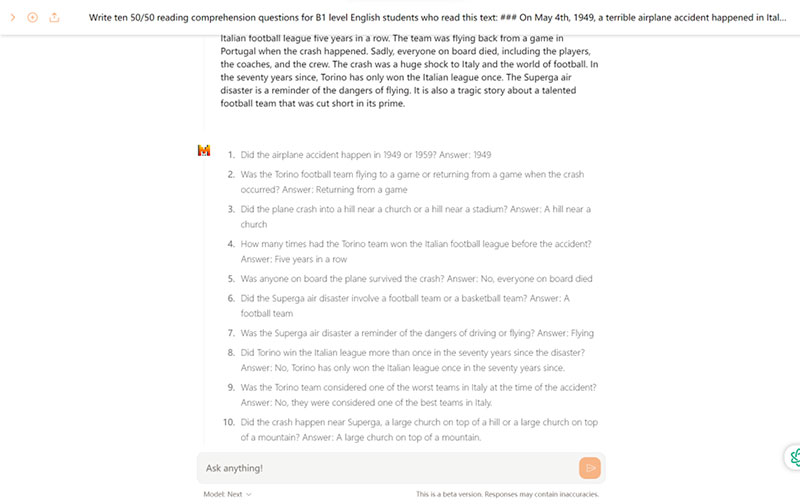
However, the questions in the example above are easy to answer. Students really don’t need to understand the passage. They just have to search for a word, then compare. If you need your students to do more thinking and inferring than that, ask the AI text generator to paraphrase in the questions.
Prompt: Write [number] [type] reading comprehension questions for B1 level English students who read the following text. When writing the questions, avoid using identical language from the text and instead paraphrase. Text: ### [text].
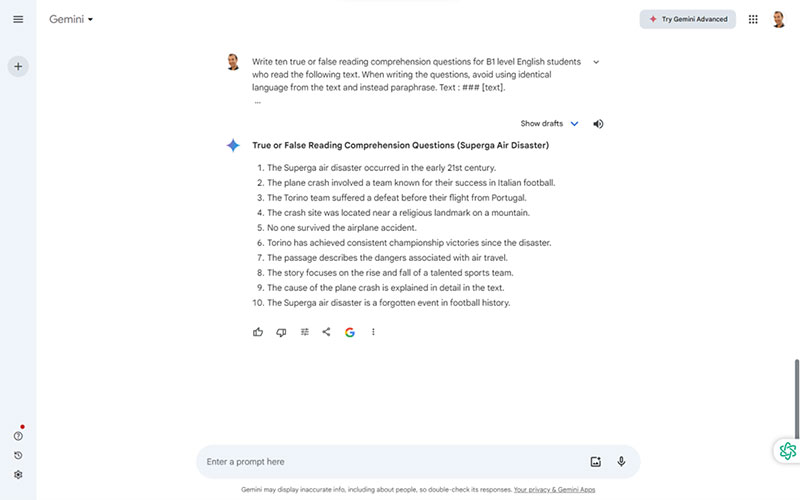
In the example above, the language in the questions is a little different to the language in the text. Learners need to think of synonyms to answer these successfully.
Using Examples
You might simply want to recreate some existing reading comprehension questions with a new passage. Perhaps you’re preparing students for an exam and need something similar to what they’ll see on the test. If so, you can use an example. This is especially useful if you want to include a variety of question types to go with a single text.
Prompt: Read through the following passage #1 and the questions. Analyze the questions and what would make these challenging for readers. Then create new questions to go with passage #2. <passage 1> [the passage] </passage 1> <questions> [the questions] </questions> <passage 2> [the new passage] </passage 2>
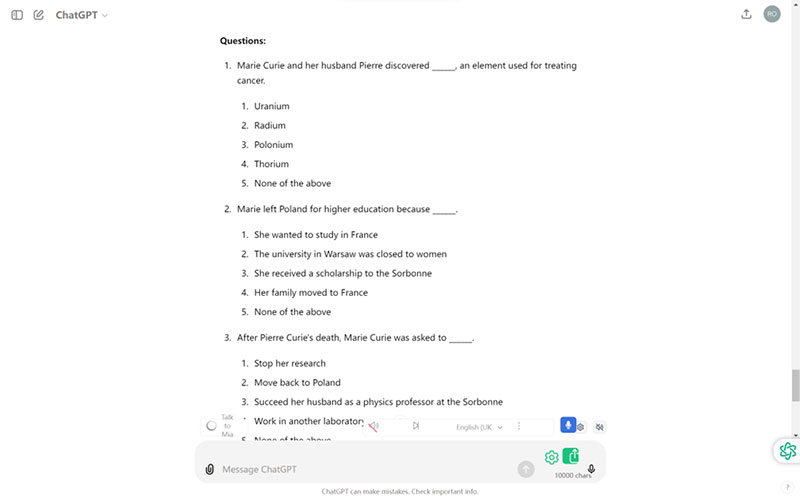
Summary and Synthesis
As we said at the start, one of the big drawbacks to reading comprehension questions, especially those focused on information, is authenticity. They don’t mirror what we do with texts outside the classroom.
One common action we take after reading is to summarise. We might summarise a book we’re working our way through, a review of a movie we’re thinking about watching or a blog post a colleague might like. We can ask students to do the same in class. Summaries are harder to mark than true or false questions. But they’re probably more useful in terms of language practice. What’s this got to do with AI? Well, you can ask AI to create a summary of a text as a model answer. Students can compare what they wrote to the model answers and pick out ideas from the AI answer that they could use to improve their own. They can also point out how the model answer could be improved.
Prompt: Please write a summary of this text using [number] words or less. Use [CEFR level] English. Text: ### [original text]

Synthesis takes summarising a step further. Synthesis asks students to take ideas from different sources, combine them and add their own reaction. Much harder to mark than true or false, but more interesting by far.
The difficulty here can be finding more than one source for students to read before synthesising. This is where AI comes in. You can take your original text, show it to an AI text generator and ask it to create something complementary or contradictory on the same topic. Students read both texts before synthesising.
Prompt: Please write a text which gives a complementary point of view on the same topic as the text below. Include some arguments against the points made in the first text. I will show both of these to my students and ask them to write a synthesis of the two texts. Text: ### [text]

Matching Questions with Texts
We mentioned at the beginning using reading comprehension questions to practice different reading skills like skimming, scanning, connecting, visualising, predicting, summarising, and questioning. The skills need to match the text. We visualise as we read poetry but not train timetables. We skim blog posts but not novels. We predict as we read novels, but not travel guides.
AI can help by suggesting skills that might be used when reading a text outside the classroom. Show AI a text and ask it to suggest the reading skills or strategies that readers a likely to use with this kind of text. This can give us a good idea of what direction to go in with our comprehension questions. We can also ensure that at least some of the questions our students answer are authentic.
Prompt: Read the following text. Then tell me what genre of text this is and what reading skills or strategies readers are likely to use with texts of this genre. Finally, suggest some reading comprehension questions which match these skills and strategies. Text: ### [text]

Language
You may have chosen a text for your class because it includes language that you want to teach. Another approach is to find an interesting text at the right level, then find useful language in the text. This has two key advantages – the text should be natural, as you chose it based on its effect on you (instead of because it has seven examples of the past continuous in a single paragraph). It should also be interesting (that’s why you chose it). This is called a text-based approach to creating materials.
Let’s say that we’ve found an interesting text. How do we decide what language to focus on? It can be daunting looking at a paragraph, counting the instances of each grammatical feature. AI can help with this, by generating a list of less common or difficult to understand vocabulary.
Prompt: Identify vocabulary which students may find difficult from this text: ### [text]
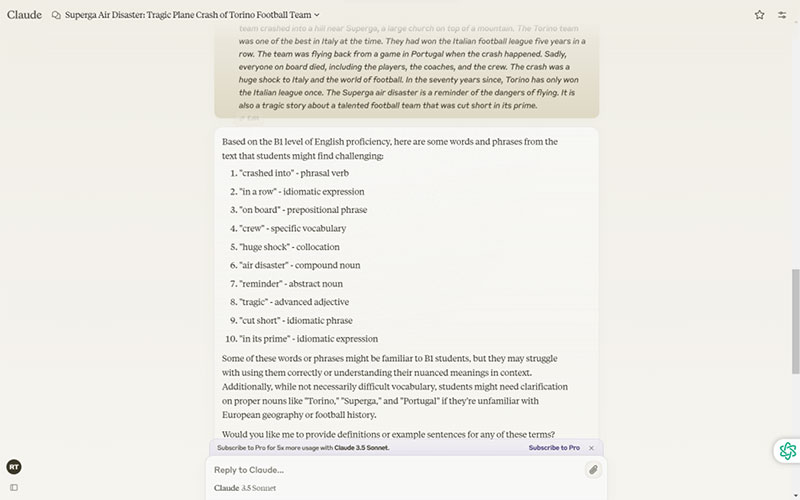
We can then ask AI to create a list of questions to encourage students to find and understand these lexical chunks.
Prompt: Create questions which can guide students to notice/discover the following lexis after reading the text for overall meaning. Lexis: ### [lexis] ### Text: ###
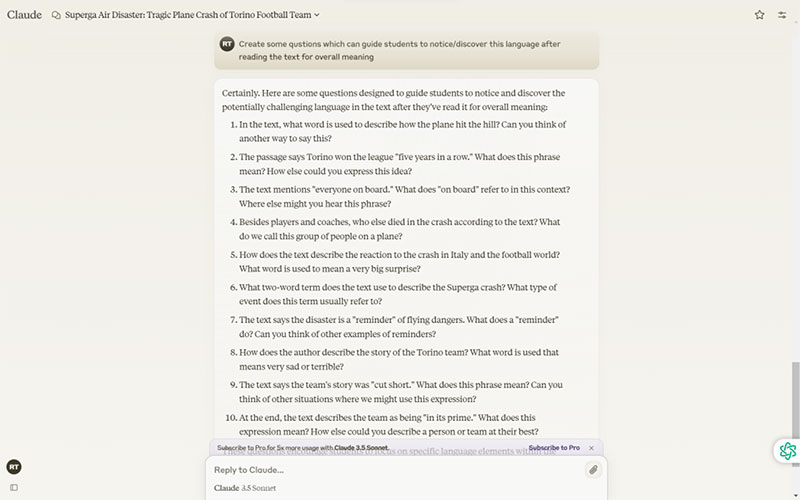
Needless to say, you don’t need to use all of these. But generating a list is a great start.
However, you might not be focused on teaching vocabulary at all. What if you want to focus on grammar? In that case, you can ask AI to analyze some grammatical features of a text and make suggestions for what to focus on in class.
Prompt: Analyze the grammatical and discourse features in the following text. Then, make suggestions for what aspects of grammar or discourse that the students who read this text could focus on in an EFL class. Tell me how many examples of each feature there are within the text. Text: ### [your text]
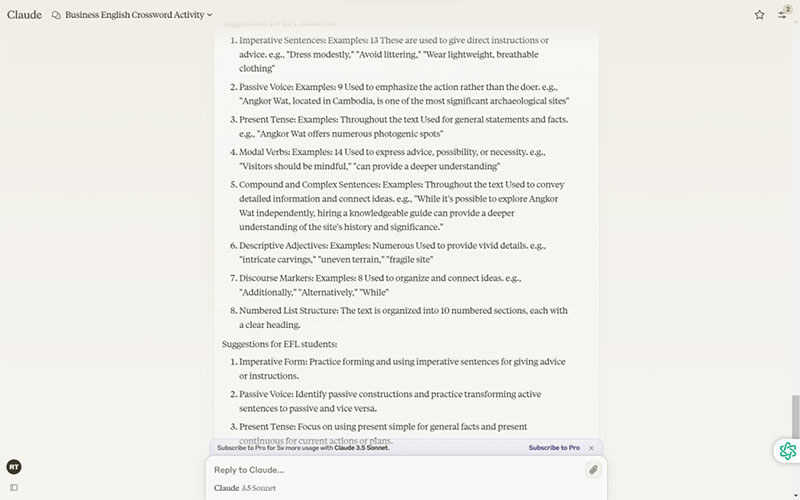
Once we’ve decided what to focus on, we can choose question types to go with the focus.
Reaction
We think as we read. In this section we’ll look at how to encourage students to share their thoughts based on what they read and prompt deeper thinking by asking interesting questions.
Personal Opinions
Opinions after reading don’t need to involve students writing long essays. Students can simply be asked yes/no questions. AI can generate suitable questions.
Prompt: Write [number] yes/no personal reaction questions for students to answer after reading the following text. The questions should elicit students’ reactions to the text rather than evaluating how much of the text they understood. Text: ### [text].
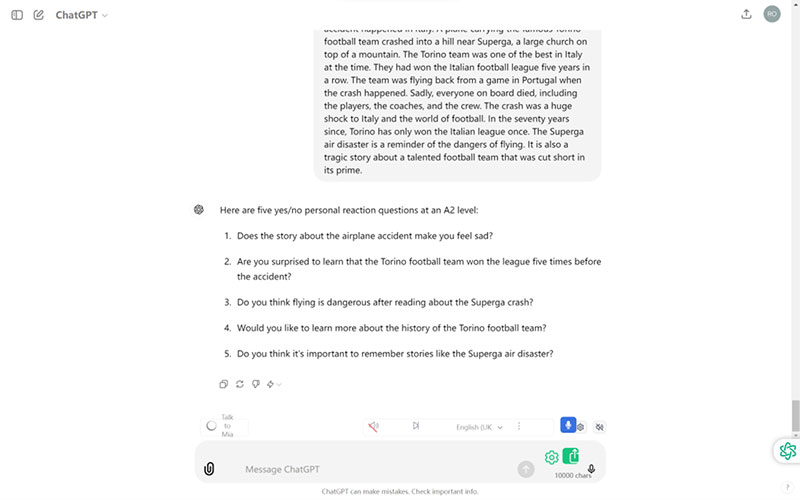
After answering the questions, students can find someone with a different opinion from their own and explain their thinking (or even try to persuade their partner to change their mind).
Critical Thinking
Let’s now look at critical thinking. We can ask AI to give us a suggestion on how to use the text to develop some critical thinking skills.
Prompt: Write ten questions for B1 level English students who have read the following text. The questions should help the learners develop their critical thinking skills. Text: ### [text].
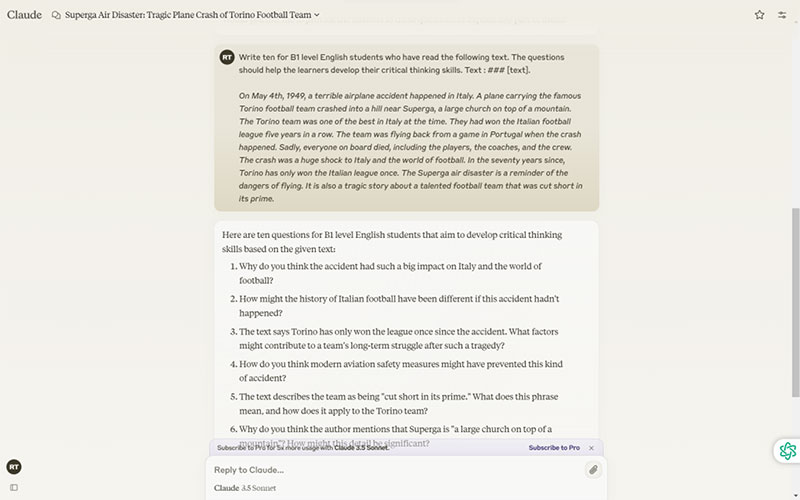
You can also ask AI to generate answers to specific activities. For example, one of my favorite critical thinking activities is to ask students to:
- Read a text
- Highlight areas of the text which are presented as fact
- Highlight areas of the text in which the author gives their opinion
- Research the facts to find out if these are true
- Decide if they agree with the opinions or not.
One of the challenges is deciding what counts as fact and what counts as opinion. An AI text generator can create sample answers for steps #2 and #3.
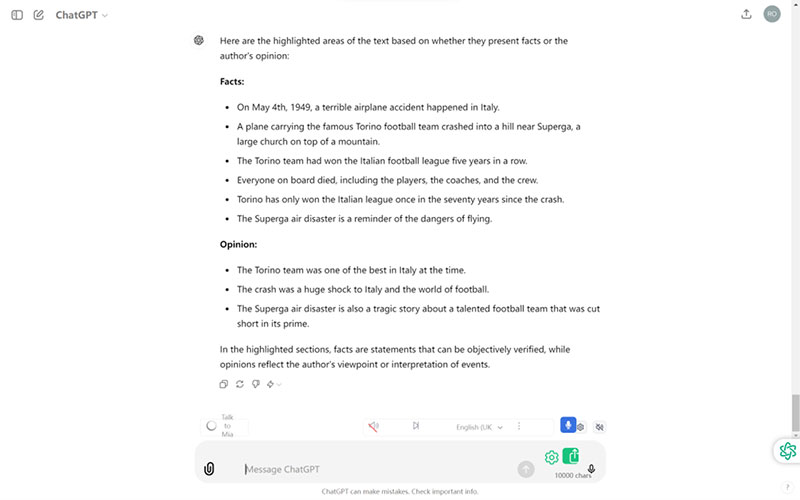
You can even use Perplexity to help fact check the facts.
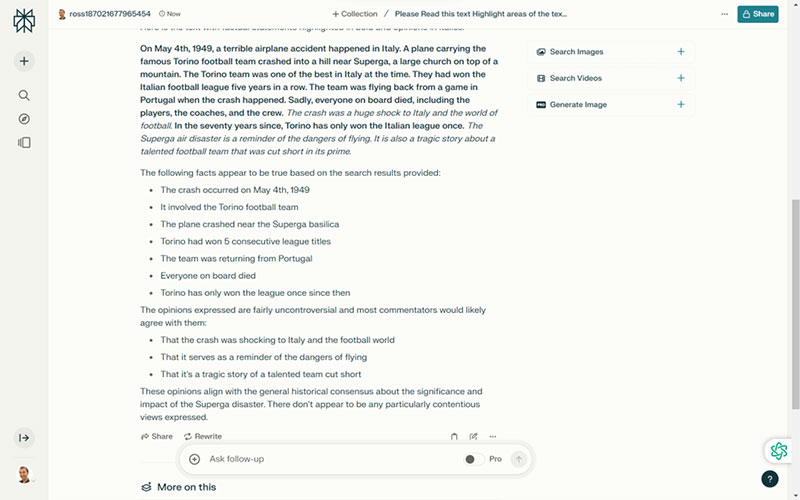
If you do this with activity with students in class, it can be useful to slip in one or two lies into the text as ‘easter eggs’ for the learners to find. This is useful training, raising awareness that learners shouldn’t believe everything they read (especially in school!)
Speaking
As we said earlier, another common reason for including a reading text in class is that it gives students something to talk about. But what are they meant to say? AI can help brainstorm speaking activities which could follow reading a text. Using a variety of text-to-text AI’s can generators a wide list of activities to choose from.
Prompt: Generate [number] meaning-based speaking activities for [CERF] level students to do after reading this text. Text: ### [text]

Changing “speaking” to “writing” in the prompt can get us a list of writing activities which match the text.
Limitations
As always, AI isn’t magic. It doesn’t produce perfect results. That doesn’t mean it should be banned, but it does mean that you need to be aware of a few things before you start using AI to create your own reading comprehension questions.
- AI tends to do better at generating closed or factual questions (e.g., multiple choice, true/false) but may struggle to create meaningful open-ended questions that encourage deeper critical thinking. (That may depend on the AI model you’re using. I was quite impressed at the suggestions from Claude, above). If you ask AI to create questions to encourage deeper thinking, analyze the questions before giving them to your students. If the questions get the cogwheels in your brain turning, they’ll probably do the same for your students.
- AI may paraphrase text to create questions, but it may not always capture the essence or key details effectively. This might lead to questions that are unclear or ambiguous. Asking AI to paraphrase can be risky. Instead of saying ‘no’, you might get some inaccurate or unnatural language use. This could confuse students about the meaning of new language in the text. Read the questions to check that they make sense.
- Question complexity. Unless told otherwise, AI tends to write in a high-ish register. This is problematic for reading comprehension questions. If the language in the questions themselves is too hard, it defeats the purpose. Your questions need to be phrased in a way that is simpler than the text they’re about. Make sure the questions are simple enough for your students to understand.
- AI may not fully grasp language nuances or cultural references embedded in texts. This might lead to questions which ignore these aspects of language. Critically evaluate any questions you get from AI and augment these with your own questions (or just supplement your questions with the best from AI).
- AI-generated questions might not align well with overall course objectives or standards. The AI won’t know why you’re doing a class on this text (unless you tell it). That means the questions might not relate to the aims of the lesson either. Either specify the aims for the questions, or generate a range and cherry pick those which most closely align with your lesson aims.
Conclusions
AI can be a helpful tool for creating reading comprehension questions, but it's not a magic solution. While AI excels at generating basic information and vocabulary-focused questions, and even suggesting activity ideas, it can struggle with deeper thinking prompts, paraphrase inaccurately, and miss cultural references. To get the most out of AI, use its suggestions as a starting point, but always review and refine the questions yourself to make sure they challenge students to think critically and engage with the text in a meaningful way. This combination of AI efficiency and your teaching expertise can create a richer learning experience for your students.
Key Takeaways
- AI can help write basic information questions by paraphrasing details.
- AI can identify difficult vocabulary or common grammatical features for language awareness questions.
- AI can suggest activities like discussions or critical thinking prompts based on the text.
- Some paraphrased questions by AI might be inaccurate, leading to student confusion.
- Check the language level of AI written questions before asking students to answer these.



